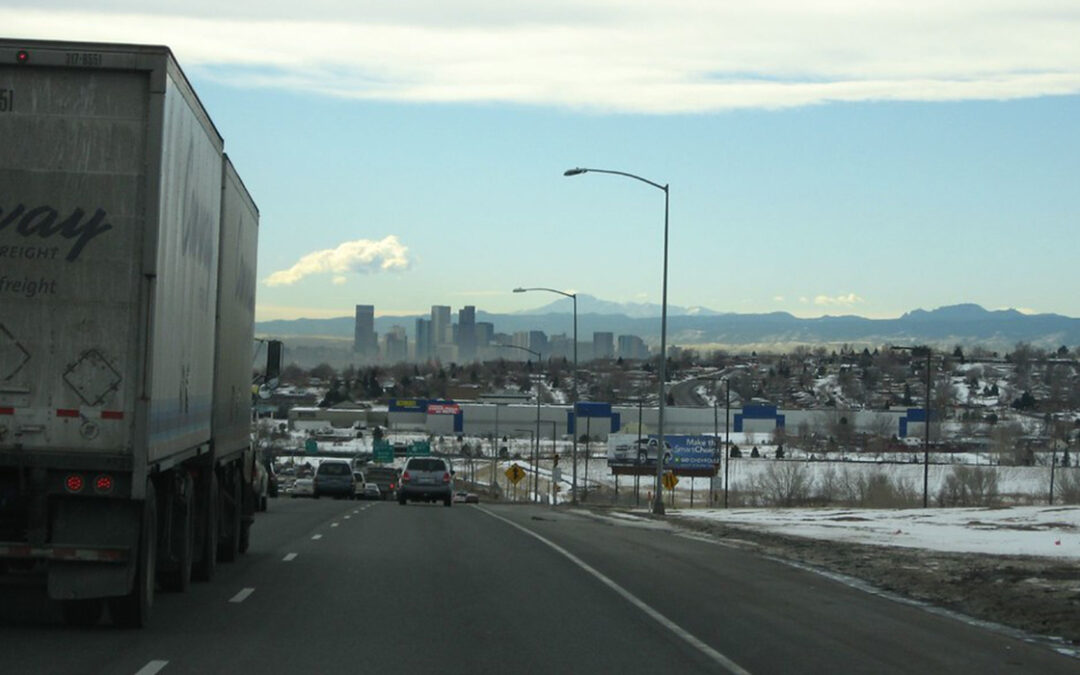
by Jennifer O'Connell | Feb 22, 2019 | Auto Accident, Colorado
I-25: Gridlock Defined
Ever driven on I-25? Then enough said. CDOT has heard our continuous gripes, as well as the stats on the horrific number of wrecks that happen at the 6th Avenue/Auraria interchange. Plans are being made to address the gridlock, and CDOT has requested that the community participate. Click here to participate in the survey regarding the project that is set to span from Santa Fe to 20th Street.
For more Colorado-related traffic and mobility concerns, check click here. And for more about how we can help, click here.

by Jennifer O'Connell | Feb 20, 2019 | Auto Accident, Colorado
In a War Between Hovercraft and Scooters, Who Wins?
Hovercraft, self-driving vehicles, autonomous buses — all modern innovations touted by the Tech Gods as the next greatest technology to hit our city streets. Just weeks ago, Tesla and other innovators debuted their versions of Jetsons-like vehicles in blue-print and digital formats at tech-gatherings across the world. And we’ve all seen YouTube videos of autonomous vehicle testing, or even experienced some of the early models on the road already. These forward-thinkers tout their devices as mechanisms of safety and traffic avoidance, as well as a mobility-method gentler to our Earth.
In fact, Denver was supposed to have its own test track for hovercraft, originally scheduled to open in 2018 by Arrivo.
Planned for just off of E-470, the testing facility was awarded $267,000 by the Colorado Office of Economic Development, according to an article published in the Denver Business Journal on February 19, 2019, but the company would only collect upon making good on their promise to bring 152 jobs to Commerce City. The company was unable to do so, and the project folded. The slow-roll of development, along with the generalized fear in the community of the safety of putting our lives in the proverbial hands of an unmanned machine or literal space-age technology just to get us to work and the grocery store, has had a major impact on the viability of these techie dreams. While the prophets of innovation are busy in their labs developing up-to-the-minute innovation, something much simpler and childhood-reminiscent has snuck into the hands of their target demographic and onto roads, sidewalks, and greenways alike.
“Micromobility” is now the name of the game.
Scooters and dockless-e-bikes are popping up like whack-a-moles on every city block in most major cities in the country. Consumers ranging from teens out for joyrides to executives escaping the gridlock morning commute are coasting alongside the rest of us still relegated to our gas-guzzlers and gas emitters. Much like the questions surrounding how to manage hover-craft safety, or even how they would be kept in their lane, the same seems to be going unanswered about the more micro methods already hitting our streets.
Denver is tackling these issues head on while simultaneously promoting the use of these alternate methods of work commuting.
At the beginning of this year, an ordinance went into effect in Denver City banning the use of scooters on sidewalks after an outcry from pedestrians who have had less than glowing reports of their shared sidewalk experiences. Additionally, the city has teamed up with B-Cycle to offer free memberships to the bike rental program in order to revitalize its use and encourage more traffic-goers to leave the ever-becoming outdated four-wheeled transport at home and take up the open-aired, two-wheeled transport. Denver is also combining its efforts to promote micro-mobility with other forms of public transit. Along with partnering with Panasonic to launch a driver-less bus to assist transit from Aurora to Denver International Airport, Denver is also working with Uber to incorporate RTD locations and schedules into its ride-share app to encourage Denverites to use Uber’s services as a gap-filler to the already existing light rail system. Denver is also making efforts to cooperate with Xcel Energy to add docking stations for electric vehicles around the city for a more energy efficient and climate-friendly commute.
All of these measures are aimed at attacking one of the most significant issues for Denver citizens, aka voters — traffic. The Denver Metro population has risen 30% in the last five years in the downtown area alone. Denver ranks 17th in the use of public transit for work commutes of major US cities. Transit commutes amount to only 6.8% for Denver workers, while 70.2% of Denver Metro residents drive alone to work. And only 2.3% of residents bike to work. Tesla and friends have suggested that hovering autos and self-driving vehicles will allow more space in the morning gridlock and more safety in high-traffic conditions. But their overall “alien” presentation to consumers combined with their molasses-like development have allowed for the swift promulgation of micro-mobility and alternatives to the old four-wheeled approach. And cities like Denver have received these substitutions with open arms. The more popular the current options become, the steeper the climb will be for innovators to launch profitable tech-commutes.
At the end of the day, we should always remain cognizant of what’s most important — safety of our community and the health of our world.
Whether scooters become more popular than hover-crafts or automated vehicles remain much more frightening than developers counted on, if these modernizations prove to protect us and our planet, we cannot be remiss in giving them due consideration. With an eye to the future, safety, and the global heartbeat, there are assuredly exciting days to come.

by Jennifer O'Connell | Feb 15, 2019 | Auto Accident, Colorado
Citations Down, Fatalities Up. Whodunnit?
On Friday, February 1, Denver Police Officers hit the highways, sweeping for speeders in what they refer to as a “saturation patrol.” And according to Jon Murray at The Denver Post, officers cited 101 drivers and warned 21 others. The average radar clock: 80 mph. The winner of the day: 110mph.
The Denver Police Department recently released stats showing that since 2009, the number of traffic citations in the county has dropped 45%, even though the population has increased by 20% over the same time period. Does this mean that all these outsiders flocking to this mountainous desert paradise are better drivers than the natives, or they at least speed less? Allow this stat to answer the question: the number of traffic-related deaths in Denver is at its highest level in a decade and the number of traffic collisions has risen 17% since 2013, according to the Denver Police Department. Is the lack of citations the cause? Or maybe police staffing? According to Murray’s article in the Post, its much more complicated than this. What appears to have occurred is an increase in population — no surprise — coupled with an increase in staffing at the Denver Police Department, which should suggest that the problem is being addressed. So why the increase in fatalities and injuries ?
Murray surmises the cause as follows: while more officers are employed by the Department, less are being directed to traffic. Their expertise is being put to other uses, such as crowd and traffic control vs patrol and other more crime-related duties. Being of the mind of our industry, we at Queener Law can’t help but also consider that the glaring increase in traffic collisions is also a culprit in and of itself.
It’s a Simple Formula:
More people + less road safety patrols = more wrecks. More wrecks + less road safety officers = more officers working scenes of wrecks and less patrolling.
Thus the dangerous spiral begins. Murray cited several public safety personnel and city officials as sharing in our concern. They offered current efforts to assign private groups to respond to collisions, leaving Denver PD officers free to maintain their posts. They also pointed to efforts to implement unmanned traffic control efforts such as red-light cameras and the like. But according to Murray, all of these efforts have been implemented in Aurora disproportionately to the rest of Denver, and even still, there has yet to be any positive effect on the fatality rates on Aurora streets.
Denver Police Department have made other changes to attempt to keep our streets safer. They’ve reassigned traffic patrol officers to closer precincts to shorten response time, according to Murray, and placed digital speed signs to keep speeds at the forefront of a driver’s mind. But we at Queener Law think this issue needs to be addressed by us, the drivers on Denver’s streets. We need our own personal call to action. Wrecks aren’t controlled by the police alone. Simple distractions, mind wanderings away from our speeds and actions, or the desire to get to our destinations on time taking precedence over strict compliance with road safety measures — these are the primary culprits.
There are many things in this world disrupting our safety, and often we feel all too helpless in protecting ourselves and our loved ones. But here’s one on which we can have a direct effect.
Let’s pledge to put our phones out of reach or on Do Not Disturb. Let’s keep our eyes and minds on the speed limits. Let’s scan our periphery in neighborhoods for pedestrians, cyclists, and other drivers who aren’t talking part in this safety pledge and might help themselves to our lanes a bit too eagerly. All in all, let’s help the Denver PD in dealing with their ever-growing road responsibilities. We can get these fatality numbers down, or even better, bring them to zero! We’ve got this, Denver!

by Jennifer O'Connell | Feb 12, 2019 | Auto Accident, Colorado
Marijuana and Traffic Safety
The conversation about whether legalization of recreational marijuana affects road safety is a common one in Colorado. Thirty-three states have legalized medical marijuana, while nine states in addition to Colorado have legalized recreational marijuana. The public seems to be continually moving towards acceptance of recreational use, but our communities are still worried about potential negative impacts in safety. And of course, the experts disagree. The journal Addiction recently cited that there is one more traffic death for every million residents in states where recreational use is legal, compared to states where recreational use is legal, compared to states without recreational legalization. The journal also cited that the states that have had legalized recreational use for more than a year have balanced back out, no longer showing an up-tick.
However, the IIHS says there are overall 6% more crashes in general, while the American Journal of Public Health says there is no change.The problem lies in the testing and current lack of accurate measurement markers for “under the influence” as it relates to marijuana. Our society is still playing a lot of catch-up to the public’s acceptance to legal use. Until the medical and legal experts develop proper testing and scaling for determining the influence marijuana has on drivers, the debate will continue. It goes without saying, though, that any driver who uses marijuana or simply takes a medication and feels cognitive effects from that should not be operating a vehicle. When a wreck occurs, BAC data and other medical markers of influence and inebriation are helpful, but they are not necessary to deciphering fault, or whether a substance influenced the driver’s ability to operate a vehicle. Diving into the facts of the collision itself and the actions taken by that driver, both before and after the collision, can provide the necessary clues.
Queener Law has tried cases for clients who were injured by drivers under the influence when there was no medical data or the medical data ceased to exist by the time of our involvement in the case. We have a network of medical experts and law enforcement experts that can help us put the pieces together. While we wait for science to catch up, with a few important facts, we may still be able to prove that the person responsible for our clients’ injuries should not have been on the road and was not in the right frame of mind. If you think your wreck applies, give us a call for a free consultation.
by Jennifer O'Connell | Nov 15, 2018 | Auto Accident, Colorado
October Proves Deadly for Motorists
During the time leading up to and including Halloween in October, motorists in Colorado need to take extra precautions to minimize their accident risks. In 2017, October had the second highest number of car accident fatalities with 3,700 deaths. Children and pedestrians are especially at risk during October. There are steps that motorists can take to mitigate their accident risks so that they can keep themselves and others safe.
Accident Dangers in October
According to the National Safety Council, 7,330 pedestrians were killed in both traffic and non-traffic accidents. Among the fatal incidents, 18 percent happened at intersections or crossings. October had the second highest number of deaths behind July with 3,700. On Halloween, children have twice the likelihood of getting killed as adults.
Reasons Why Halloween Is Dangerous
There are several factors that make Halloween especially dangerous for children and pedestrians. Most people go trick or treating from 5:30 pm to 9:30 pm. During that time frame, it gets darker making it harder for motorists to see pedestrians and children. Children might dart out into the roads. Many Halloween costumes are made out of dark materials. Some motorists may be out celebrating Halloween at parties where drinking occurs. All of these factors can combine to make fatal pedestrian accidents more likely to happen.
Mitigating the Risk of Accidents
There are several steps that people can take to mitigate the risk of accident involvement on Halloween. Parents may want to choose brightly colored costumes for their children or to place reflective tape on the costumes so that they can be seen. Responsible adults should accompany children while they trick or treat so that they don’t run out into traffic. Motorists should never drink and drive at any time, including Halloween. When people are driving, they should obey the speed limits and watch for pedestrians on the sidewalks, recognizing that children may suddenly try to dash across the roadways. Drivers should also watch out for children who are on curbs or in medians as they may try to cross without warning.
Parents should discourage teens from driving on Halloween. They might be likelier to cause auto accidents by failing to see children who are wearing dark costumes. Finally, people should not wear masks that make it difficult for them to see and should exercise caution when they prepare to cross the streets.

by Jennifer O'Connell | Oct 22, 2018 | Auto Accident, Colorado
What is Whiplash?
Whiplash is a common type of car accident injury in Colorado that can cause long-term complications for some victims that can reduce the quality of their lives. People who are involved in auto accidents should promptly seek medical attention. Some people may not initially recognize that they have been injured. Whiplash injury symptoms may not appear for hours or days after an accident. Getting prompt medical treatment may help people recover faster and may build stronger evidence that the whiplash resulted from their accidents. The most common type of car accident that may cause whiplash is a rear-end collision. When a vehicle is traveling slower than a vehicle that is approaching from behind or is at a standstill when it is struck, an occupant of the front vehicle may suffer whiplash.
Whiplash includes potential injuries to the neck, shoulders, head, ligaments, muscles, and bones. When a rear vehicle collides into a front vehicle, a front vehicle’s car occupants may have their heads and necks violently propelled forward because of the physical forces of the collision. As the forces subside, their heads and necks may be thrown backward, causing them to be hyper-extended. This violent front-to-back movement can cause multiple injuries to the muscles, ligaments, and bones of the neck and shoulders. While some people might recover from whiplash in a matter of weeks, others may face complications and chronic symptoms that can continue for months or years and that impact their ability to work and to enjoy life.
Complications of Whiplash
The Mayo Clinic reports that the common symptoms of whiplash may develop within 24 hours, but it may also take longer for them to appear. These symptoms include neck pain that worsens when people move their necks or turn their heads, reduced the range of motion of the neck, headaches, shoulder and arm pain, tingling in the arms, dizziness, and fatigue. People who suffer severe whiplash injuries may suffer the following complications:
- Chronic, severe headaches
- Pain radiating from the neck and shoulders into the arms
- Chronic, severe neck pain
Complications from whiplash can cause ongoing problems and interfere with the victims’ ability to function, making it crucial for people to get treatment.





